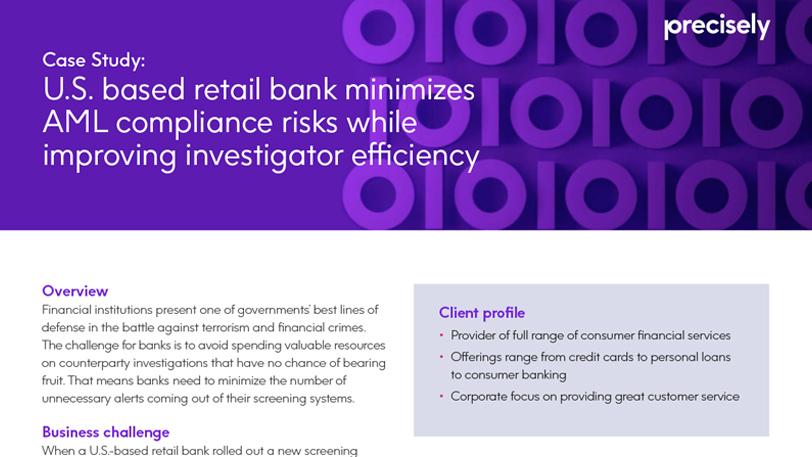Customer Story
U.S. Based Retail Bank Minimizes AML Compliance Risks While Improving Investigator Efficiency
Overview
Financial institutions present one of governments’ best lines of defense in the battle against terrorism and financial crimes. The challenge for banks is to avoid spending valuable resources on counterparty investigations that have no chance of bearing fruit. That means banks need to minimize the number of unnecessary alerts coming out of their screening systems.
Business challenge
When a U.S.-based retail bank rolled out a new screening application, it immediately experienced a spike in alerts. Every day, the screening system compared the bank’s clients, counterparties and transactions against dozens of watch lists from governments around the world. The tool was generating too many false positives, because the bank didn’t have a single, consolidated view of each customer.
Consider what might happen with an individual who holds a prominent position in a foreign government, and who is known by four different combinations of her first, middle and last names. She may open accounts under all four names. If the bank does not recognize the different names as belonging to a single individual, its screening system may generate four alerts for her in a given day, rather than just one. Misspellings and other data-entry errors could potentially expand that number even further.
This was a significant problem at the U.S.-based retail bank. One Russian oil baron appeared in the bank’s systems 67 times with slightly altered names or job titles. The bank’s new screening tool was generating far more alerts than necessary to identify the individuals who actually created risk for the bank.
This situation was wasting staff resources. Regulatory compliance requires a financial institution to have investigators research the alerts that come out of its screening system.
Understanding that unnecessary investigations were consuming a great deal of staff resources, the management team at the bank set out to reduce the number of unwarranted investigations their staff was undertaking.
Read more about how the Precisely solution reduced 58 percent the volume of false positives that the bank’s investigators must pursue.
